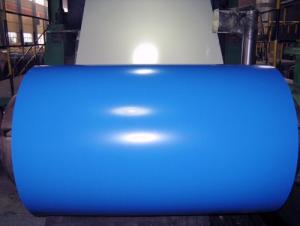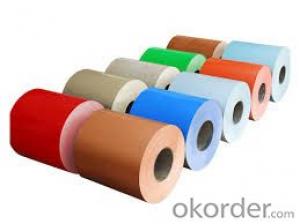Prepainted Galvanized Steel Coil
- Loading Port:
- China Main Port
- Payment Terms:
- TT OR LC
- Min Order Qty:
- -
- Supply Capability:
- -
OKorder Service Pledge
Quality Product, Order Online Tracking, Timely Delivery
OKorder Financial Service
Credit Rating, Credit Services, Credit Purchasing
You Might Also Like
Prime PPGI Coils, ASTM A 653 CS type B, Z120 suitable for
corrugated metal roofs. Coil weight: 5 MT max.
Top: 5 microns primer + 20 microns RMP
Back: 7 microns mill's standard grey primer coat RAL 7035
Size: 0.50mm TCT x 1200mm x CColor: RAL 9002.
- Q:I have a knife with 154cm steel on it and I always here that you should put oil on it to keep it from rusting but I am just wondering what kind of oil? And how do I apply it and do I just leave it on there?
- It's stainless steel so it doesn't really need to be oiled. Anything will do for oil if you want to wipe it down. Just put a little on a paper towel and give it a once-over.
- Q:Are steel coils corrosion-resistant?
- Yes, steel coils can be made corrosion-resistant through various methods such as galvanization or coating them with protective layers.
- Q:How are steel coils used in the production of metal buildings?
- Steel coils are an essential component in the production of metal buildings as they are used to create the structural framework and outer cladding. These coils are unrolled and cut into sheets, which are then shaped and formed into various building components such as beams, columns, and panels. The strength and durability of steel make it an ideal material for constructing metal buildings, ensuring they are capable of withstanding harsh weather conditions and providing long-lasting structures.
- Q:How are steel coils inspected for paint adhesion?
- Various methods and techniques are utilized to inspect the adhesion of paint on steel coils. One commonly employed method is the tape test, which involves pressing adhesive tape onto the painted surface and swiftly removing it. The amount of paint that is lifted off by the tape is then examined to assess the adhesion. If the paint adheres well to the steel, only a minimal amount of paint will be removed. Another method employed is the crosshatch adhesion test. This test entails making parallel cuts on the painted surface using a sharp blade, creating a crosshatch pattern. A piece of adhesive tape is then applied over the cuts and rapidly pulled off. The evaluation of the paint that is removed from the crosshatched area determines the adhesion. Furthermore, a visual inspection is frequently conducted to evaluate the overall appearance and adhesion of the paint. Inspectors search for any indications of cracking, peeling, or bubbling, which may indicate poor adhesion. They also check for any areas where the paint may have chipped or flaked off. Moreover, various laboratory tests can be conducted to assess the paint adhesion on steel coils. These tests may include techniques like the pull-off test, where a specialized device is used to measure the force required to remove a small section of the paint from the surface. Other tests may involve subjecting the painted surface to extreme temperature or humidity conditions to assess the paint's performance under different environmental factors. In summary, a combination of visual inspections, tape tests, crosshatch adhesion tests, and laboratory tests are employed to thoroughly inspect steel coils for paint adhesion. These tests ensure that the paint adheres effectively to the steel surface, resulting in a durable and long-lasting finish.
- Q:What are the environmental benefits of using steel coils?
- Using steel coils offers several environmental advantages. To begin with, steel is a highly recyclable material. Steel coils can be easily recycled and transformed into new steel products, reducing the necessity for mining and extracting raw materials. Recycling steel also consumes less energy than producing it from scratch, resulting in lower greenhouse gas emissions and a smaller carbon footprint. Moreover, steel is renowned for its durability and longevity. When employed in construction or manufacturing, steel coils can endure for decades without compromising their structural integrity. This reduces the need for frequent replacements, which, in turn, decreases resource consumption and the energy required for production. Additionally, steel exhibits exceptional resistance to corrosion and weathering, making it an ideal choice for outdoor applications. Its ability to withstand harsh environmental conditions means that steel coils can maintain their functionality for extended periods, reducing waste generation and the environmental impacts associated with replacing damaged or deteriorated materials. Lastly, steel is an adaptable material that finds utility in a wide range of industries and applications. Its versatility allows for efficient resource utilization, as steel coils can be easily adjusted and customized to meet specific project requirements. This adaptability also enables the use of steel in sustainable building designs, such as energy-efficient structures or green buildings that incorporate renewable energy systems. In conclusion, the use of steel coils brings about environmental benefits related to their recyclability, durability, resistance to corrosion, and versatility. Opting for steel coils in various applications contributes to resource conservation, reduced carbon emissions, and a more sustainable future.
- Q:How are steel coils secured during transportation?
- Steel coils are typically secured during transportation using steel strapping, bands, or wire rope. These securements help prevent the coils from shifting or falling off the transportation vehicle, ensuring their safe delivery to the destination.
- Q:How are steel coils used in the manufacturing of transmission shafts?
- Steel coils are used in the manufacturing of transmission shafts by being converted into cylindrical shapes through a process known as coil winding. These coils are then cut, shaped, and machined to create the desired dimensions and specifications for the transmission shafts. The high strength and durability properties of steel make it an ideal material for transmission shafts, ensuring efficient power transmission and overall performance of the machinery.
- Q:How are steel coils used in the manufacturing of heat shields?
- Steel coils are used in the manufacturing of heat shields as they provide a durable and heat-resistant material to create the shield. The coils are typically cut and shaped into the desired form, allowing for precise customization and efficient production. The steel's high melting point and strength make it ideal for shielding against intense heat, ensuring the protection of surrounding components or structures.
- Q:How are steel coils used in the production of rail tracks?
- Steel coils are used in the production of rail tracks as they are processed and shaped into rails. These coils are transformed into long, straight sections of steel that form the main structure of the track. This process involves cutting, bending, and welding the coils to create the desired rail shape and dimensions. The resulting rails are then installed on rail beds to provide a durable and reliable foundation for trains to run on.
- Q:im writing a book.-how is steel made? like, from what natural resources?-is there a type of factory that just prouduces steel to then be made into the various things made out of steel? if so, what kind of company might that be?-what is the first stage of steel, like, right after the other....ingrediants......are mixed, but before it is shaped into whatever its destined to be?thank you so much, i really appreciate it!
- Iron and Carbon, mostly. It can include Manganese, Chromium, Vanadium, Tungsten, and a couple of others, depending on what it will be used for.
1. Manufacturer Overview |
|
|---|---|
| Location | |
| Year Established | |
| Annual Output Value | |
| Main Markets | |
| Company Certifications | |
2. Manufacturer Certificates |
|
|---|---|
| a) Certification Name | |
| Range | |
| Reference | |
| Validity Period | |
3. Manufacturer Capability |
|
|---|---|
| a)Trade Capacity | |
| Nearest Port | |
| Export Percentage | |
| No.of Employees in Trade Department | |
| Language Spoken: | |
| b)Factory Information | |
| Factory Size: | |
| No. of Production Lines | |
| Contract Manufacturing | |
| Product Price Range | |
Send your message to us
Prepainted Galvanized Steel Coil
- Loading Port:
- China Main Port
- Payment Terms:
- TT OR LC
- Min Order Qty:
- -
- Supply Capability:
- -
OKorder Service Pledge
Quality Product, Order Online Tracking, Timely Delivery
OKorder Financial Service
Credit Rating, Credit Services, Credit Purchasing
Similar products
New products
Hot products
Hot Searches
Related keywords




























